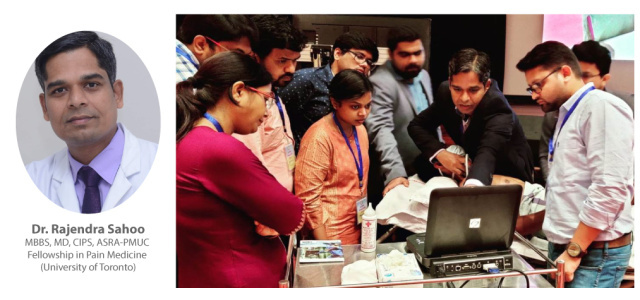
We recently interviewed Dr. Rajendra Sahoo, Senior Consultant Pain & Palliative care at Kalinga Institute of Medical Sciences, Bhubaneswar to learn about the various clinical aspects and the utility of point-of-care ultrasound (POCUS) in his routine professional practice.
When did you start using ultrasound in your professional practice?
I was introduced to the world of ultrasound since the early days of my residency training in 2008 at Mumbai. It was the first hands-on program that fueled the zeal in me for further upgradation of my skills. Since then, I have been extensively using point-of-care ultrasound in regional anesthesia, pain medicine, musculoskeletal scanning and for perioperative care.
How do you find ultrasonography useful or different than other imaging modalities?
Ultrasonography has revolutionized the practice of modern regional anesthesia, interventional pain management, critical care and emergency medicine, given its wider use and varied point-of-care of applications. In the last one and half decades, the art and science of regional anesthesia has rapidly improved only because of the advent of compact ultrasound machines. It has helped anesthesiologists provide nerve blocks to sick, medically unfit patients for the purpose of pain relief and surgical anesthesia. The precision and accuracy of local anesthetic deposition around the target structures, and avoidance of injury to surrounding structures has been the hallmark of ultrasound technology. This subsequently improved the patient satisfaction and reduced the complication rates. It is often told that you can divide anesthesiologists into two groups- ones who are abreast of ultrasound technology use in anesthesia and others who are not.
Similarly, ultrasound in interventional pain management has improved by leaps and bounds in recent times. Pain physicians often rely on fluoroscopy as an imaging modality while performing many interventional pain procedures. However, recently the paradigm has changed. Yes, fluoroscopy is still used for spine interventions but for musculoskeletal structures like major joints, bursae, tendons, muscles, and various nerve pathologies, ultrasound is undoubtedly one of the most preferred imaging modalities. It avoids radiation exposure, and helps in bedside dynamic scanning and therapeutic interventional procedures. In modern pain clinics, we use bedside ultrasound systems to confirm our clinical diagnosis in many musculoskeletal and neuropathic pain conditions.
Which ultrasound system are you currently using and for which clinical applications?
Currently, I am using Sonosite Edge II ultrasound machine at my pain center and quite often utilize this system for diagnosis of various musculoskeletal pain conditions like arthritis, shoulder pain, wrist, hip, knee and ankle pain and nerve related pain conditions. Additionally, it helps me in performing bedside interventional pain procedures for arthritis, shoulder pain conditions, soft tissue pain from tendinosis, tenosynovitis, joint effusions, and entrapment neuropathy.
I also perform various ultrasound guided nerve blocks for surgical anesthesia and to provide postoperative pain management using Sonosite Edge II machine.
How has point-of-care ultrasound proven useful in your day-to-day patient care? Brief about any interesting case studies where ultrasound was helpful in right decision making.
Point-of-care ultrasound has been the utmost turning point in my modern pain practice. The case examples are plenty. However, I will highlight one recent case of wrist and fingers pain. This patient had typical features of carpal tunnel syndrome (CTS) which happens because of compression of the median nerve at the wrist. She had been suffering from severe tingling pain in the fingers and numbness which the neurologist had rightly diagnosed as CTS, but the nerve conduction study was normal and unfortunately, the pain was not getting relieved with the standard medications. When the patient visited me, I did a diagnostic ultrasound and found a cyst compressing the median nerve. I aspirated the wrist under ultrasound guidance and patient was relieved of her pain.
Tell us about some of your academic endeavors and upcoming plans for propagating ultrasound education in your area of expertise?
We have been trying hard to propagate the knowledge and science of ultrasound to the young generation doctors. I am part of many ultrasound teaching courses, and in fact we run various courses to train the budding anesthesiologists to learn ultrasound for their day-to-day practice. I have conducted hands-on courses in the past to train physicians. Currently, in our department, ultrasound teaching and demonstration of blocks happen on an everyday basis and we encourage our resident doctors to learn it so that their patients get benefitted.
In future, I have plans to conduct regional anesthesia, POCUS and musculoskeletal ultrasound courses and even certificate courses for pain physicians.


